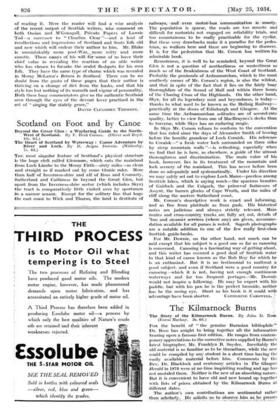Scotland on Foot and by Canoe THE most singular feature
of Scotland's physical structure is the huge cleft called Glenmore, which cuts the mainland
from Loch Linnhe to the Moray Firth—sixty miles—as clean and straight as if marked out by some titanic ruler. More than half of Inverness-shire and all of Ross and Cromarty, Sutherland and Caithness he beyond the Great Glen, but apart from the Inverness-shire sector (which includes Skye) the tract is comparatively little visited save by sportsmen in a narrow season. Except for the solitary 'line that hugs the east coast to Wick and Thurso, the land is destitute of
railways,- .-,and---eren motar:bui communication is --seanty. The population is sparse, the roads are too remote and difficult for motorists not engaged on reliability trials, and too mountainous to be really practicable for the cyclist. But these very drawbacks make it a paradise for the pedes- trian, as walkers here and there are beginning to discover. It is for the pedestrian that Mr. Corson has written his admirable book.
Remotene, it is well to be reminded; beyond the Great Glen is not a question of northerliness or westerliness so Much as of the freakishness of the West Coast of Scotland. Probably the peninsula of Ardnamurchan, which is the most southerly corner of Mr. Corson's region, is also the wildest, iind. that in spite of the fact that it lies on the fairly busy thoroughfare of the Sound of Mull and within three hours of the Charing Cross of the Highlands. On the other hand, Skye, for all its legendary mist and beyondness, is today— thanks to what used to be known as the Mallaig Railway— practically at the doors of Edinburgh and Glasgow. At the same time the Ardnamurchan solitudes are of second-rate quality, better to view from one of MacBraynes's decks than to traverse, while Skye has an enduring magic.
In Skye Mr. Corson refuses to conform to the convention that has ruled since the days of Alexander Smith of bowing before the horrific grandeur of Loch Coruisk. His reference to Coruisk—" a fresh water loch surrounded on three sides by steep mountain walls "—is refreshing, especially when we find that he is here, as elsewhere, a guide of the utmost thoroughness and discrimination. The main value of his book, however, lies in its treatment of the mountain and loch scenery of the mainland. This has never before been done so adequately and systematically. Under his direction we may safely set out to explore Loch Maree—peerless among Scottish lakes, which is saying much—the spacious beauties of Gairloch and the Coigach, the primeval fastnesses of Assynt, the barren glories of Cape Wrath, and the miles of cliff along the austere Sutherland coast.
Mr. Corson's descriptive work is eXact and informing, and as free from platitude as froth gush. His historical notes are judicious and always strictly relevant. Main routes and cross-country tracks _am fully set out, details of 'bus and steamer services (where any) are given, accommo- dation available for all purses is noted. Superb photographs are a notable addition to one of the few really first-dais Scottish guide-books.
For Mr. Downie, on the other band, not much can be said except that his subject is a good one so far as canoeing is concerned. Canoeing is a fascinating way of getting about, and this writer has covered a good deal. of Scottish water in that kind of canoe known as the Rob Roy for which he is an enthusiast. But it is no testimonial to maltreat good subject, and even if Scotland were a good country for canoeing—which it is not, having not enough continuous waterways and far too frequent portages—Mr. Downie would not inspire 'a following. He may be expert with his paddle, but with his pen he is the perfect bromide, neither has he the seeing eye. Short as his book is it could with
'advantage have been shorter. CATHERINE CARSWELL.
















































 Previous page
Previous page